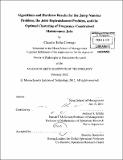Algorithms and hardness results for the jump number problem, the joint replenishment problem, and the optimal clustering of frequency-constrained maintenance jobs
Author(s)
Telha Cornejo, Claudio (Claudio A.)
DownloadFull printable version (7.613Mb)
Other Contributors
Massachusetts Institute of Technology. Operations Research Center.
Advisor
Andreas S. Schulz.
Terms of use
Metadata
Show full item recordAbstract
In the first part of this thesis we present a new, geometric interpretation of the jump number problem on 2-dimensional 2-colorable (2D2C) partial order. We show that the jump number of a 2D2C poset is equivalent to the maximum cardinality of an independent set in a properly defined collection of rectangles in the plane. We then model the geometric problem as a linear program. Even though the underlying polytope may not be integral, we show that one can always find an integral optimal solution. Inspired by this result and by previous work of A. Frank, T. Jordan and L. Vegh [13, 14, 15] on set-pairs, we derive an efficient combinatorial algorithm to find the maximum independent set and its dual, the minimum hitting set, in polynomial time. The combinatorial algorithm solves the jump number problem on convex posets (a subclass of 2D2C posets) significantly faster than current methods. If n is the number of nodes in the partial order, our algorithm runs in 0((n log n)2.5) time, while previous algorithms ran in at least 0(n9 ) time. In the second part, we present a novel connection between certain sequencing problems that involve the coordination of activities and the problem of factorizing integer numbers. We use this connection to derive hardness results for three different problems: -- The Joint Replenishment Problem with General Integer Policies. -- The Joint Replenishment Problem with Correction Factor. -- The Problem of Optimal Clustering of Frequency-Constrained Maintenance Jobs. Our hardness results do not follow from a standard type of reduction (e.g., we do not prove NP-hardness), and imply that no polynomial-time algorithm exists for the problems above, unless Integer Factorization is solvable in polynomial time..
Description
Thesis (Ph. D.)--Massachusetts Institute of Technology, Sloan School of Management, Operations Research Center, 2012. Cataloged from PDF version of thesis. Includes bibliographical references (p. 107-110).
Date issued
2012Department
Massachusetts Institute of Technology. Operations Research Center; Sloan School of ManagementPublisher
Massachusetts Institute of Technology
Keywords
Operations Research Center.